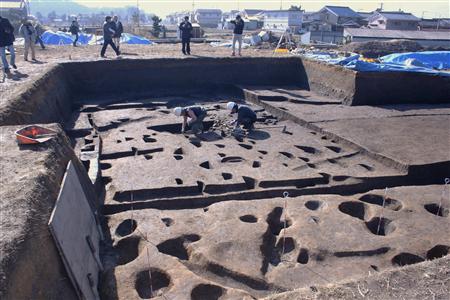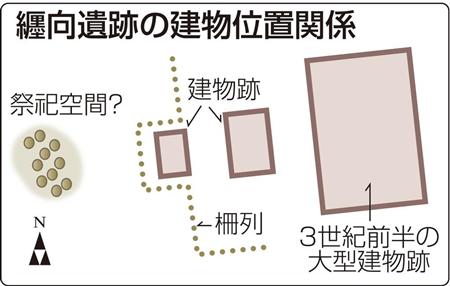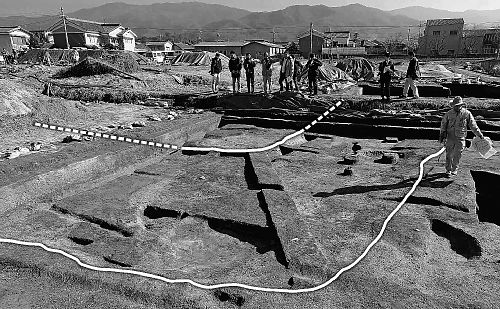Following the 2009 and 2011 finds of several large buildings, it was announced on February 1 that over 100 postholes dating to the early 3rd century were found at the Makimuku site (纒向遺跡) in Sakurai city, Nara Prefecture. Clustered within an approximately 60-square-meter area to the west of the building complex, they appear to represent the repeated reconstruction of a small-scale building.
Picture source
An excavation in 2009 revealed evidence of four buildings dating to the early 3rd century aligned along an east-west axis at the center of the Makimuku site (see post linked to above for previous discussion). One of the buildings measures 238 square meters, the largest building discovered thus far for its time, and is posited as the palace of Queen Himiko, the shaman queen mentioned in the Chinese History of the Three Kingdoms (Sanguozhi). This most recent find, however, suggests that the building located furthest west was no building at all. The postholes of the building did not pan out. It would appear that the building complex contained three buildings, in addition to the posthole cluster.
Many researchers consider Makimuku to be the location of Yamatai, the 3rd-century capital of the kingdom of Wa.
An additional excavation in 2011 revealed evidence of another building 5 meters to the east of the supposed site of Himiko’s palace. 3 rectangular post holes, believed to have supported thick pillars, each measuring 1.2 meters across and 60 centimeters deep stretch for 9 meters; 2 square post holes, believed to have supported relatively smaller pillars (these tsukabashira [束柱] are believed to have supported the flooring) are located one each between the larger holes. Archaeologists suspect that this building may in fact be of the same size and construction of the building positioned as Himiko’s palace. The building found in 2011, however, dates to the late 3rd century/4th century, according to pottery found on site, separating it from the time of Himiko, who is recorded in the Chinese chronicle to have died around 248 AD.
The numerous postholes vary in size, from 10 to 60 centimeters in diameter. They are believe to be located at the entrance to the building cluster.
Far left: postholes; center: two buildings flanked by pillared fence; far right: monumental building dating to early 3rd century [notice the posthole cluster replaced the building furthest west]; Picture source
According to Tatsumi Kazuhiro, a former professor at Doshisha University, the building may have been the stage for rituals celebrating bountiful harvests, the signs of rebuilding suggesting that the building was torn down and reconstructed each time.
Additionally, a section of a moat was found dating to the middle of the 4th century. The section stretches approximately 45 meters east-to-west and 7.5 meters north-to-south. At its maximum, it is 5.8 meters wide and over 60 centimeters deep. Judging from past excavations, it is believed to stretch around 57 meters east-to-west. The moat is believed to have surrounded this central area.
Picture source
Picture source
While no contemporary buildings have been found yet within its borders, a wooden ritual object in the shape of a sword measuring 31.5cm long was uncovered.
This post will be updated as more information is released. While much of our understanding is fragmentary, it is at least clear that this area was home to continued occupation and ritual use for around 150 years and overlapped with both Himiko’s rule and the beginning of monumental keyhole-tomb construction in the vicinity.
———–
Original article source
卑弥呼の祭祀用建物跡?奈良・纒向遺跡で柱穴100個超出土
2013.2.2
宮殿エリア西側で出土した100個以上の柱穴群=奈良県桜井市の纒向遺跡
邪馬台国の最有力候補地とされる奈良県桜井市の纒向(まきむく)遺跡で、女王・卑弥呼(ひみこ)が君臨した時期にあたる3世紀前半の小型建物の柱穴が100個以上見つかり、市教委が1日、発表した。約60平方メートルの狭いエリアに集中し、小型建物を建てたり壊したりした跡とみられる。遺跡の中心部で柱穴が集中して確認されたのは初めてで、専門家は「年に数回、卑弥呼が特別に執り行った祭祀(さいし)用の建物跡ではないか」とみている。
市教委は過去の調査を踏まえ、遺跡の中心部は、卑弥呼の宮殿とも指摘される3世紀前半の大型建物を含む4棟の建物が東西に並んでいたと推定。今回、昭和53年に柱穴の一部が確認されていた最も西側の建物の推定地を調査し、この建物に関連する柱穴は確認されなかったが、周辺で直径10~60センチの柱穴を100個以上確認した。
市教委によると、建物群の入り口にあたるとみられ、「特別な空間」として利用された可能性が高いという。古代祭祀に詳しい辰巳和弘・元同志社大教授(古代学)は「卑弥呼が年に数回、食物の収穫を感謝する祭祀のたびに建てられ、祭祀後に取り壊された複数の小型建物の痕跡ではないか」と推測している。
一方、今回の調査では、4世紀中頃に整備された豪族居館の周濠(しゅうごう)跡の一部も確認された。過去の調査を踏まえ、周濠の規模は東西約65メートル、南北約54メートル、幅は最大5・8メートル、深さ最大60センチ以上と判明した。
市教委は「3世紀の宮殿エリアを囲むような周濠で、この周辺のエリアが、世紀をまたいで政治や祭祀の神聖な土地として利用されていたのではないか」とみている。
現地説明会は3日午前10時から。JR桜井線巻向駅の西方徒歩約5分。
–
奈良・纒向遺跡:西端建物、不透明に 想定の柱穴見つからず 毎日新聞 2013年02月02日 大阪朝刊 多数見つかった柱列。過去に見つかった柱列は手前にある=奈良県桜井市辻の纒向遺跡で2013年1月31日午前11時5分、矢追健介撮影 拡大写真 邪馬台国の最有力地とされる奈良県桜井市の纒向(まきむく)遺跡で、東西に真っすぐ並んでいたと想定された3世紀前半の建物群のうち、西端の1棟が存在しない可能性が高いことが発掘調査でわかった。1日に発表した桜井市教委によると、建物に合う柱穴の列はなく、より広い範囲に大量の柱穴が見つかった。 西端の建物は女王卑弥呼(ひみこ)(248年ごろ没)の宮殿に関連する施設ともされていた。市教委は「想定と異なる形の建物が建てられていた可能性がある」としている。 昨年11月からの調査で、約180平方メートルの範囲から直径約10〜60センチの柱穴が約80個見つかった。うち数十個は3世紀前半のものという。 これまでの調査では、宮殿ともされる大型建物を東端に、計4棟の建物が東西の直線を軸に南北対称に建てられていたと想定された。西端の建物は、柱穴5個の柱列を北側部分とし、東西約5メートル、南北約8・3メートルの大きさと考えられていた。 しかし、今回の調査で建物の南側の柱穴が見つからず、想定していた形と異なることが明らかになった。 兵庫県立考古博物館の石野博信館長は「考えられていた建物は無かったが、小さいけれども大事な建物を何度も建てた神聖な空間であった可能性がある」としている。現地説明会は3日午前10時から午後3時まで。雨天中止。【矢追健介】
–
大和王権の中枢?溝出土…纒向遺跡 大規模な施設の周りに巡らされていたとみられる溝(白線が溝の南西角にあたる)(奈良県桜井市の纒向遺跡で)=野本裕人撮影 奈良県桜井市の纒向 まきむく 遺跡で、大規模な施設の外周を巡っていたとみられる4世紀中頃の溝が東西45メートル、南北7・5メートルにわたって出土し、市纒向学研究センターが1日、発表した。邪馬台国の時代から約1世紀後の遺構で、専門家は、この地で成立したとされる大和王権の中枢部だった可能性を指摘している。 見つかった溝は幅4・7~5・8メートル、深さ20~60センチで南西の角にあたる。これまでの調査では、南東の角が出土しており、東西の長さは57メートルと確定。南北は地形などから、54メートル以上あるとみられる。 溝の内側では、同時期の建物跡などは確認されていないが、祭祀 さいし 用の刀形木製品(長さ31・5センチ)などが出土。重要な祭祀場か、有力者の居館だった可能性も考えられるという。 付近では、邪馬台国の宮殿との説もある3世紀前半~中頃の大型建物跡が出土しており、白石太一郎・大阪府立近つ飛鳥博物館長(考古学)は「時代は離れているが、王権が継続して利用していた場所ではないか」と話している。 ただ、邪馬台国時代以降、この周辺で誕生したとされる大和王権は、どこに宮殿があったのかなど、実態はわかっていない。「日本書紀」には垂仁 すいにん 天皇の「纒向珠城 たまき 宮」、垂仁天皇の子で日本武尊 やまとたけるのみこと の父にあたる景行 けいこう 天皇の「纒向日代 ひしろ 宮」という宮殿が登場しており、関連が注目される。 現地説明会は3日午前10時~午後3時。雨天中止。JR巻向駅の近く。10日には午前10時から、東京・よみうりホールで開かれるフォーラム「纒向出現」(読売新聞社後援)でも調査成果を報告する。問い合わせは同センター(0744・45・0590)。 石野博信・兵庫県立考古博物館長の話「溝の規模から内側は特別な空間で、聖なる儀式が営まれていたとも考えられる。大和王権の宮殿との関係が、明らかになることを期待したい」 (2013年2月2日 読売新聞)



